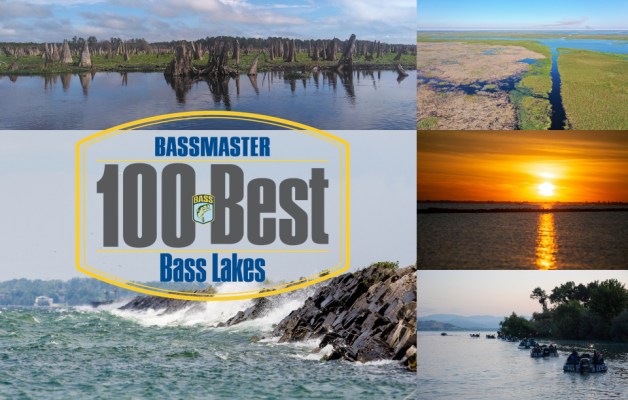
![<h4>1. Sacramento-San Joaquin Delta, California</h4>[1,100 square miles] <BR>
Although always high on our list, the rank of these tidal waters has consistently dropped over the past five years as average sizes and trophy fish stats have declined, with the blame falling mostly on pillaging sea lions and aquatic vegetation spraying. But regardless of the cause, the Deltaâs rivers, tule-lined sloughs and vegetation-filled flooded islands are back with a vengeance. Based on an analysis of 170 Western tournaments taking place on 50 bodies of water, this river system has come out as the best of the best in terms of both the average weight fish needed to win and the largest bass caught. The heaviest one-day limit here came during an April Best Bass Tournaments event in which the top team brought five largemouth to the scales for 35.06 pounds â including a 9.47 kicker! The 11th-place team had an even better fish that went 11.26 pounds. The cream of the crop during the first part of 2021, however, was an impressive 13.81-pound monster caught from the back seat during a Wild West Bass Trail Pro/Am in March.](http://www.bassmaster.com/wp-content/uploads/2021/07/bbl_w_1_sacrementosanjoaquin_mg_8281_overstreet-scaled.jpg)
Although always high on our list, the rank of these tidal waters has consistently dropped over the past five years as average sizes and trophy fish stats have declined, with the blame falling mostly on pillaging sea lions and aquatic vegetation spraying. But regardless of the cause, the Deltaâs rivers, tule-lined sloughs and vegetation-filled flooded islands are back with a vengeance. Based on an analysis of 170 Western tournaments taking place on 50 bodies of water, this river system has come out as the best of the best in terms of both the average weight fish needed to win and the largest bass caught. The heaviest one-day limit here came during an April Best Bass Tournaments event in which the top team brought five largemouth to the scales for 35.06 pounds â including a 9.47 kicker! The 11th-place team had an even better fish that went 11.26 pounds. The cream of the crop during the first part of 2021, however, was an impressive 13.81-pound monster caught from the back seat during a Wild West Bass Trail Pro/Am in March.
![<h4>2. Clear Lake, California</h4>[43,785 acres] <BR>
When it comes to numbers of big largemouth itâs difficult to beat the Golden Stateâs most expansive natural lake, where relatively shallow waters and high productivity create ideal growing conditions. There were 428 anglers at the WON Bass California Open in April, bringing 6,184 fish to the scales over three days totaling 21,441 pounds. It took over 60 pounds to make the Top 19 on the pro side at the event. The heaviest single-day limit at the time of this writing was 54.38 pounds for seven bass, caught in March at a NewJen team contest. And big fish of the year, landed the same month at a Chamber of Commerce tournament, tipped the scales at a whopping 12.79.](http://www.bassmaster.com/wp-content/uploads/2021/07/bbl_w_2_clearlake4-scaled.jpg)
When it comes to numbers of big largemouth itâs difficult to beat the Golden Stateâs most expansive natural lake, where relatively shallow waters and high productivity create ideal growing conditions. There were 428 anglers at the WON Bass California Open in April, bringing 6,184 fish to the scales over three days totaling 21,441 pounds. It took over 60 pounds to make the Top 19 on the pro side at the event. The heaviest single-day limit at the time of this writing was 54.38 pounds for seven bass, caught in March at a NewJen team contest. And big fish of the year, landed the same month at a Chamber of Commerce tournament, tipped the scales at a whopping 12.79.
![<h4>3. El Capitan Reservoir, California </h4>[1,562 acres] <br> El Cap sounds like a small body of water, but itâs actually one of San Diegoâs largest. This is also one of the regionâs famed big bass producers, with the lake record largemouth sitting at 15.31 pounds. It took more than 20 pounds to finish in the top eight at a Wild West Bass Trail team tournament in late April, with the champions weighing five bass for 28.14. Big fish was a hefty 13.39-pound giant. El Cap gets plenty of fishing pressure, but a limited operating schedule gives bass weekly breaks â check the City of San Diego website to see when the reservoir is open before going.](http://www.bassmaster.com/wp-content/uploads/2021/07/bbl_w_3_elcapitan1-scaled.jpg)
![<h4>4. Diamond Valley Lake, California </h4>[4,500 acres] <br>This is one of the newest reservoirs in the West, and when built it had no fish. That gave biologists the unique opportunity of creating whatever type of fishery they wanted. Thankfully they decided to make Diamond Valley a trophy lake, stocking only near-pure strain largemouth. Their efforts crafted what is now the most consistent big bass producer west of the Rockies. It took an average of almost 28 pounds to win each of ten contests held here between January and April. Big fish at those events ranged from 6.45 to 10.37 pounds.](http://www.bassmaster.com/wp-content/uploads/2021/07/bbl_w_4_diamondvalley1-scaled.jpg)
![<h4>5. Lake McClure, California </h4>[7,000 acres]<br> Anglers that havenât fished this foothill reservoir in a while may be surprised to find it on this yearâs Best Bass Lakes list, while those that know just how special it can be may be upset that it made the cut. Historically, this was an average lake producing average fish. But quality bass are the name of the game here now. Although 15 pounds is often enough to win here, on occasion it takes a lot more. An early March American Bass team contest was taken with five bass weighing 27.74 pounds. Big fish was 12.19.](http://www.bassmaster.com/wp-content/uploads/2021/07/mcclure.jpg)
![<h4>6. Lake Hodges, California </h4>[1,234 acres] <br>Some may recognize this San Diego reservoir as the home of Hodgee, the resident lake monster that draws lots of attention despite a lack of evidence confirming its existence. The lakeâs monster bass, however, are a well-documented fact. It took a 5.5-pound average to win an American Bass team tournament in April, with the fourth-place team weighing in a 9.65-pound big fish. Hodges is open on a limited basis, so be sure to check the City of San Diego website for the current schedule before going.](http://www.bassmaster.com/wp-content/uploads/2021/07/bbl_w_6_lakehodges-scaled.jpg)
![<h4>7. Lake Coeur dâAlene, Idaho </h4>[31,487 acres] <br>The waters in this large glacial lake get cold. Really cold! So, a warm-water species doing well here doesnât exactly make sense. But logic doesnât always come into play when other fishing conditions are just right. Big bass coming out of Coeur dâAlene is nothing new â itâs almost always taken 20-plus-pound bags to win here. What is different is that in 2021 anglers have needed closer to 30 pounds to claim victory. It took weights of 27.64, 27.93 and 33.41 to win three American Bass contests here in April.](http://www.bassmaster.com/wp-content/uploads/2021/07/bbl_w_7_lakecoeurdalenecda2-scaled.jpg)
![<h4>8. Lake Havasu, Arizona/California </h4>[19,300 acres] <br>What do you get when you mix close to 300 days of sunshine, clear turquoise waters and easy access? Arizonaâs Playground where crowds flock for every water-related activity that exists, including some of the best largemouth and smallmouth fishing (stripers are a bonus) in the region â it often takes 20 pounds or better to claim victory. At a February JML Outdoors event the winners lugged 25.72 pounds to the scales. A 10.18-pound bass took big fish honors at an American Bass tournament in January.](http://www.bassmaster.com/wp-content/uploads/2021/07/bbl_w_8_havasu_150510lhaz_1707-scaled.jpg)
![<h4>9. Coeur dâAlene River Chain Lakes, Idaho </h4>[7,710 acres combined] <br>These 10 223- to 1,640-acre lakes running along the Coeur dâAlene River for 17 miles are relatively shallow and provide outstanding habitat for bass. Some are more difficult to get to than others, with access to eight of the 10 available by boat from the river. The 10.94-pound state record largemouth came out of Anderson Lake (year unknown), while the 25-inch (estimated at 9.7 pounds) catch-and-release record came from Cave Lake in 2019.](http://www.bassmaster.com/wp-content/uploads/2021/07/bbl_w_9_coeurdalene_chain_roselake2.jpg)
![<h4>10. Saguaro Lake, Arizona </h4>[1,264 acres]<br> Nestled in the Sonoran Desert and surrounded by steep canyon walls, Saguaro is ideal for anyone that enjoys targeting rocky structure. This isnât the place for numbers, but itâs tough to beat for big bass, with lots of man-made fish-holding habitats adding to the quality. Although weights appear to be down slightly, it still takes fish averaging almost 5 pounds to win here. Four bass for 18.63 pounds won a JML Outdoors Cashion Cup Solo Series event in March. Big fish at that one was 7.62.](http://www.bassmaster.com/wp-content/uploads/2021/07/bbl_w_10_saguarolake_mesa_debra_husbandcowley.jpg)
![<h4>11. Tenmile Lake, Oregon </h4>[1,626 acres] <br>A coastal lake in the Pacific Northwest can only mean one thing, right? Salmon, steelhead and trout. But guess again. Tenmile, due to habitat alterations, has become the north coastâs dominant bass lake featuring largemouth 6 pounds and bigger. The relatively small lake has a bunch of fingers and coves providing more shoreline than expected â close to 170 miles! In the seven 2021 tournaments we looked at, from February through May, big fish honors went to four 5-pound, one 6-pound and a pair of 7-pound bruisers.](http://www.bassmaster.com/wp-content/uploads/2021/07/bbl_w_11_tenmile_race_to_weighin_mikegray_odfw.jpg)
![<h4>12. Lake Casitas, California </h4>[1,100 acres] <br>Stocked trout are a staple of the trophy-sized largemouth in Casitas and are largely responsible for some of the highest fish growth rates observed in the bass fishing world. As a result, a handful of the biggest bass caught in the country have come from here, including Raymond Easleyâs epic 21.3-pound behemoth taken in 1980. But you can also catch lots of fish to 5 pounds using shad imitations if you donât want to fish for that one big bite. The top team at an American Bass derby boated 23.17 to win. Big fish was 7.18.](http://www.bassmaster.com/wp-content/uploads/2021/07/bbl_w_12_casitasca_californialake_w_2016.jpg)
![<h4>13. Potholes Reservoir, Washington </h4>[27,800 acres]<br> There are more largemouth than smallmouth in this irrigation impoundment, but the fishing for both is excellent. Ample vegetation and more than 1,000 flooded islands (when the water is high) on the north and west sides of the lake provide lots of targets for the green variety, while the brown fish can be caught off rockpiles to the east and south. At Northwest Bassâ Berkley Big Bass Tournament in April, there were seven fish over 5 pounds caught, with a 5.98 big bass.](http://www.bassmaster.com/wp-content/uploads/2021/07/bbl_w_13_potholesreservoir_2019.jpg)
![<h4>14. Roosevelt Lake, Arizona </h4>[21,493 acres] <br>This Salt River impoundment was known for huge bass. But minimal habitat and the introduction of gizzard shad put an end to that. The Roosevelt Lake Habitat Enhancement Project (expected completion in 2027), however, is bringing big fish back. The venture is helping to meet the stateâs âHawgâ management goals by adding lots of artificial structure. A 21.88-pound winning weight at a JML Outdoors Cashion Cup Solo Series contest in April, that included an 8.26-pound largemouth, is proof of the lakeâs revival.](http://www.bassmaster.com/wp-content/uploads/2021/07/bbl_w_14_rooseveltlake_ronniedowns.jpg)
![<h4>15. South Fork Reservoir, Nevada </h4>[1,640 acres] <br>The Nevada Department of Wildlife admits that the stateâs biggest waters, including Mead and Mohave, get most of the attention from bass anglers. But they believe that a few smaller destinations to the north actually fish better, with South Fork being the best. This young lake was built specifically for recreation, with minimal water level fluctuations creating ideal conditions for its largemouth and smallmouth. Biologist Chris Drake says the lake produces largemouth to just over 8 pounds, with 20-fish days common.](http://www.bassmaster.com/wp-content/uploads/2021/07/bbl_w_15_southfork_dsc_0144-scaled.jpg)
![<h4>16. Fort Peck Reservoir, Montana </h4>[245,000 acres] <br>Although the state is known for its Rocky Mountains and blue-ribbon trout fisheries, eastern Montana produces some exceptional bassing opportunities too. Fort Peck, on the Missouri River, is a prime example with almost 1,600 miles of shoreline â thatâs more than the combined coasts of California, Oregon and Washington. Most bass fall in the 2- to 3-pound category, but fish to 5- pounds and bigger are available. Last year Theron Thompson broke the smallie state record in October with a 7.84-pound fish.](http://www.bassmaster.com/wp-content/uploads/2021/07/peck.jpg)
![<h4>17. Siltcoos Lake, Oregon</h4> [3,164 acres] <br>Oregonâs largest coastal lake is 3 miles from the Pacific and 13-feet above sea level. As expected, it has cold-water fishes. But whatâs surprising is the bass fishery that it supports, with dropoffs, fallen trees and submerged vegetation providing cover to largemouth averaging 3 to 4 pounds. There are not, however, many big bass here, with 5- and 6-pound fish rarely making an appearance. It took over 20 pounds to make the top four at a TBF Coastal Circuit event here earlier this year, with a 22.55 limit and 6.18 big fish taking top honors.](http://www.bassmaster.com/wp-content/uploads/2021/07/bbl_w_17_siltcooslake3-scaled.jpg)
![<h4>18. Lake Washington, Washington </h4>[21,934 acres] <br>This glacially-created lake is unique, with inlets at both ends and a central man-made outlet. Itâs characterized by steep, highly urbanized banks with thousands of docks. The Washington Department of Fish and Wildlifeâs Warmwater Program studies indicate that largemouth numbers are down, while smallmouth are up. Angler surveys are consistent, revealing smallies as the preferred target. Both, however, get sizable. A 7.01 largemouth and a 5.76 smallmouth were big fish at a Washington Bass Association event in March.](http://www.bassmaster.com/wp-content/uploads/2021/07/bbl_w_18_lakewashington_2018.jpg)
![<h4>19. Lake Oroville, California</h4> [15,500 acres] <br>Orovilleâs 167 miles of shoreline is tough to beat for numbers of fish. The reservoir, however, has avoided our list for one simple reason â the bass here have always been relatively small. But things are changing. Although it still only takes bass averaging 3 to 3 1/2 pounds to win, anglers now need one much larger to claim a big fish prize. Eighty percent of the tournaments we examined this year had at least one bass over 6 pounds. The biggest was an 11.79 monster weighed in at a Wild West Bass Trail team event in February.](http://www.bassmaster.com/wp-content/uploads/2021/07/bbl_w_19_oroville_19ebc-watershoot-boatfishing-08-scaled.jpg)
![<h4>20. Dworshak Reservoir, Idaho</h4> [17,090 acres]<br> This North Fork Clearwater River impoundment is known for massive smallmouth. Bass sizes, however, have been down due to fewer numbers of the protein-rich kokanee that they love to eat. Dworshak, as a result, didnât even make our previous list. But itâs back in 2021. According to an April news release from Idaho Fish and Game, the kokanee estimates here are up 75%. It looks like smallie sizes are on the upswing too. In May 2020, Dustin Shepherd broke the catch-and-release record with a 22.75-inch fish.](http://www.bassmaster.com/wp-content/uploads/2021/07/bbl_w_20_dworshak_paul_pence_national_resource_manager_dworshak_dam.jpg)
![<h4>21. Lake Pleasant, Arizona</h4> [12,040 acres] <br>You know this lake, less than an hourâs drive from Phoenix, gets crowded when seeing its 10-lane ramp. But donât let the skiers deter you â there are plenty of secluded arms and coves to get away from the hordes. Largemouth are the target here. Big fish at a March JML Outdoors event tipped the scales at 7.75.](http://www.bassmaster.com/wp-content/uploads/2021/07/bbl_w_21_lakepleasant_dsc_7715-scaled.jpg)
![<h4>22. Lower Colorado River, Arizona/California</h4> [76 miles from Blythe to Imperial Dam] <br>Bass anglers donât find a lot of river fishing in the west, but this part of the Colorado offers some of the best around. There are loads of fish-holding backwaters and access points. It took 17 to 22 pounds to win three American Bass tournaments here this year, with a 6.02-pounder winning big fish during a January event.](http://www.bassmaster.com/wp-content/uploads/2021/07/bbl_w_22_lowercolorado1-scaled.jpg)
![<h4>23. Columbia River, Oregon/Washington</h4> [191 miles from Portland to McNary Dam] <br>Anglers familiar with this Pacific Northwest river werenât happy when resource agencies altered regulations, aimed at reducing bass numbers, in efforts to increase salmon survival. Although the impacts of the changes arenât fully clear, there do seem to be higher numbers of large bass. It took 20 pounds to make the top three at a TBF team contest in April, with the winners weighing 26.29. Two tied for big bass with 7.14-pounders.](http://www.bassmaster.com/wp-content/uploads/2021/07/bbl_w_23_columbiariver_431-scaled.jpg)
![<h4>24. Lake Mead, Nevada/Arizona</h4> [158,080 acres]<br> Mead and other Colorado River reservoirs have always been subject to drought and low-water conditions. The system, however, is looking at extremes this time around, with storage predicted to shrink to historic lows. No one really knows how it will impact bass, but for now itâs still one of the best according to Nevada Department of Wildlife staff specialist Pat Sollberger. It took largemouth averaging 4.25 pounds, and a 5.80 kicker, to win an American Bass team event in April.](http://www.bassmaster.com/wp-content/uploads/2021/07/bbl_w_24_lakemead_mg_0365_ronniemoore.jpg)
![<h4>25. Lake Powell, Utah/Arizona </h4> [108,335 acres] <br>Powell anglers can expect to see both good and bad effects due to the ongoing record-breaking drought. Itâs always been a numbers game here, and though itâs unclear whether conditions will hurt fisheries in the long term, 50-bass days will be more common with lower waters concentrating fish. The good fishing resulted in every team at two Ultimate Bass tournaments, in April and May, weighing limits. Note, however, that getting to the fish is more difficult and less safe due to ramp closures and new submerged hazards.](http://www.bassmaster.com/wp-content/uploads/2021/07/bbl_w_25_lakepowell_houseboat_nationalrecreation_area_uot-scaled.jpg)




